A Study on Application of Recloser Operation Algorithm for Mixed Transmission System Based on Travelling Wave Method
Abstract
1. Introduction
2. Conventional Recloser Operation Principles
3. Proposed Recloser Operation Algorithm for Mixed Transmission System
3.1. Configuration: (OL + UC)
3.2. Configuration: (OL + UC + OL)
3.3. Configuration: (UC + OL + UC)
4. Simulation and Verification
4.1. Simulation Conditions
4.2. Simulation Results and Verification
4.3. Setting for Different Conditions and Results
5. Conclusions
- Simple and convenient to use: The proposed approach uses instantaneous voltage information, which is sampled data by PT (Potential Transformer) on buses, and did not apply signal processing. Thus, there are no requirements for additional devices and the signal processing procedure when utilities try to apply the proposed algorithm on their recloser.
- Cost efficiency: As above-mentioned, except PTs, additional equipment (including GPS or computation device) is not required to apply the proposed approach. Additionally, because the function of the proposed algorithm performs simple subtraction and comparison, it has a low computation time. Thus, the proposed approach has a low computation cost. In addition, because the proposed algorithm is based on a single ended method, which differs from existing approaches that are mostly based on a double ended method, it requires a relatively smaller number of devices.
- Expansion ability: The proposed approach uses the characteristics of various conductors that consist of a mixed transmission line. According to the type of conductor, characteristics including the propagation speed of the travelling wave are changed. By considering the propagation speed of the travelling wave and setting proper reference values (, , ), the proposed algorithm can be applied to any type of conductors. Furthermore, a mixed transmission line is operated under many different topologies. In this paper, only three types (OL + UC, OL + UC + OL, UC + OL + UC) were considered, but this can be expanded to many topologies (OL + UC + OL + UC, OL + UC + UC + OL, and so on) by adding more reference values.
Author Contributions
Funding
Conflicts of Interest
Nomenclature
| Variables | |
| Tref | A reference value to distinguish the faulted section |
| Tsample | The arrival time that travelling wave propagates from fault point to measuring point |
| ∆T | The difference between fault occurring time and Tsample |
| L | length of overhead line or underground cable |
| v | propagation velocity of travelling wave |
| Abbreviations | |
| OL | Overhead line |
| UC | Underground cable |
| OC | Overhead line + Underground cable |
| OCO | Overhead line + Underground cable + Overhead line |
| COC | Underground cable + Overhead line + Underground cable |
Appendix A
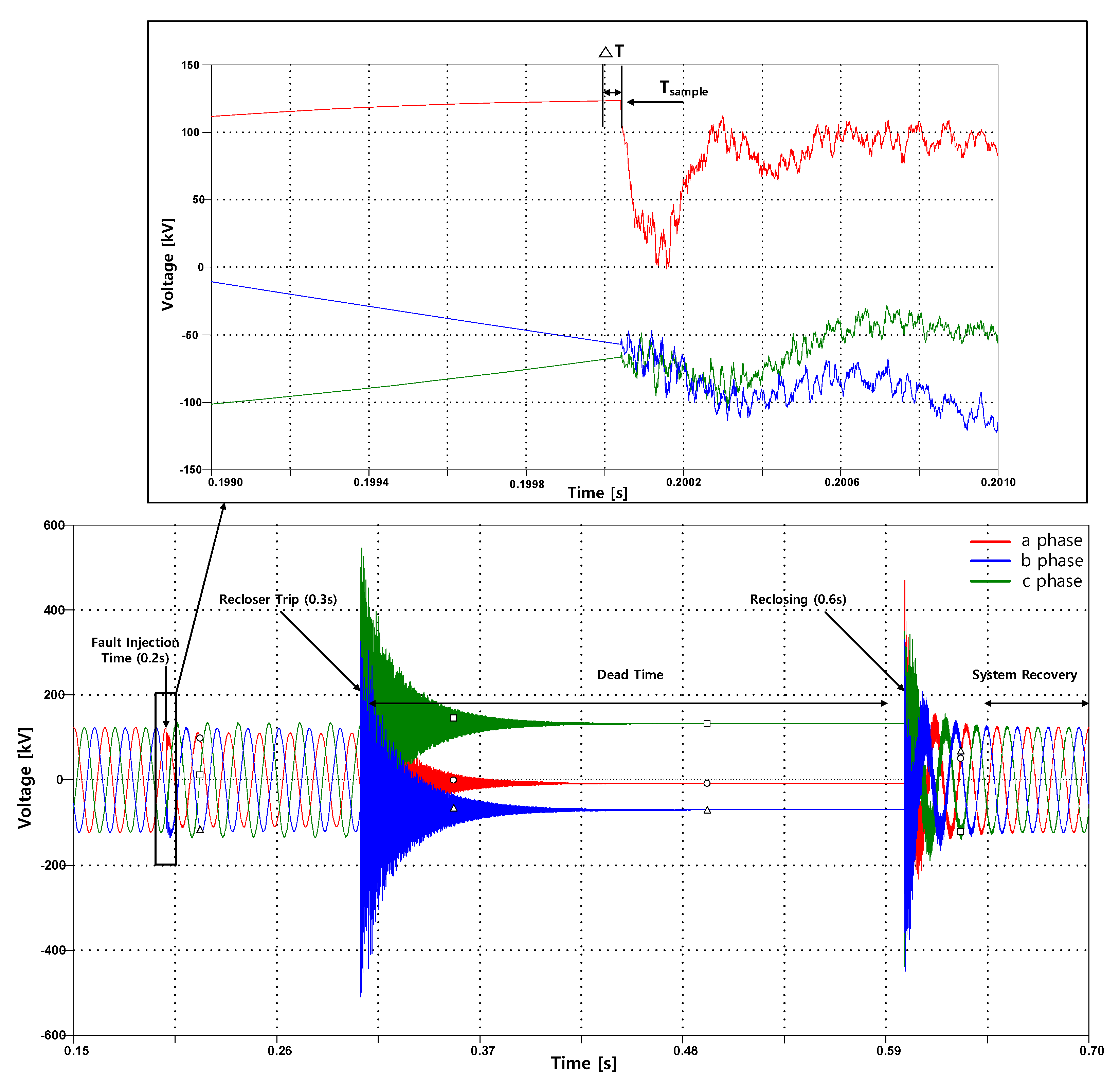
Appendix B
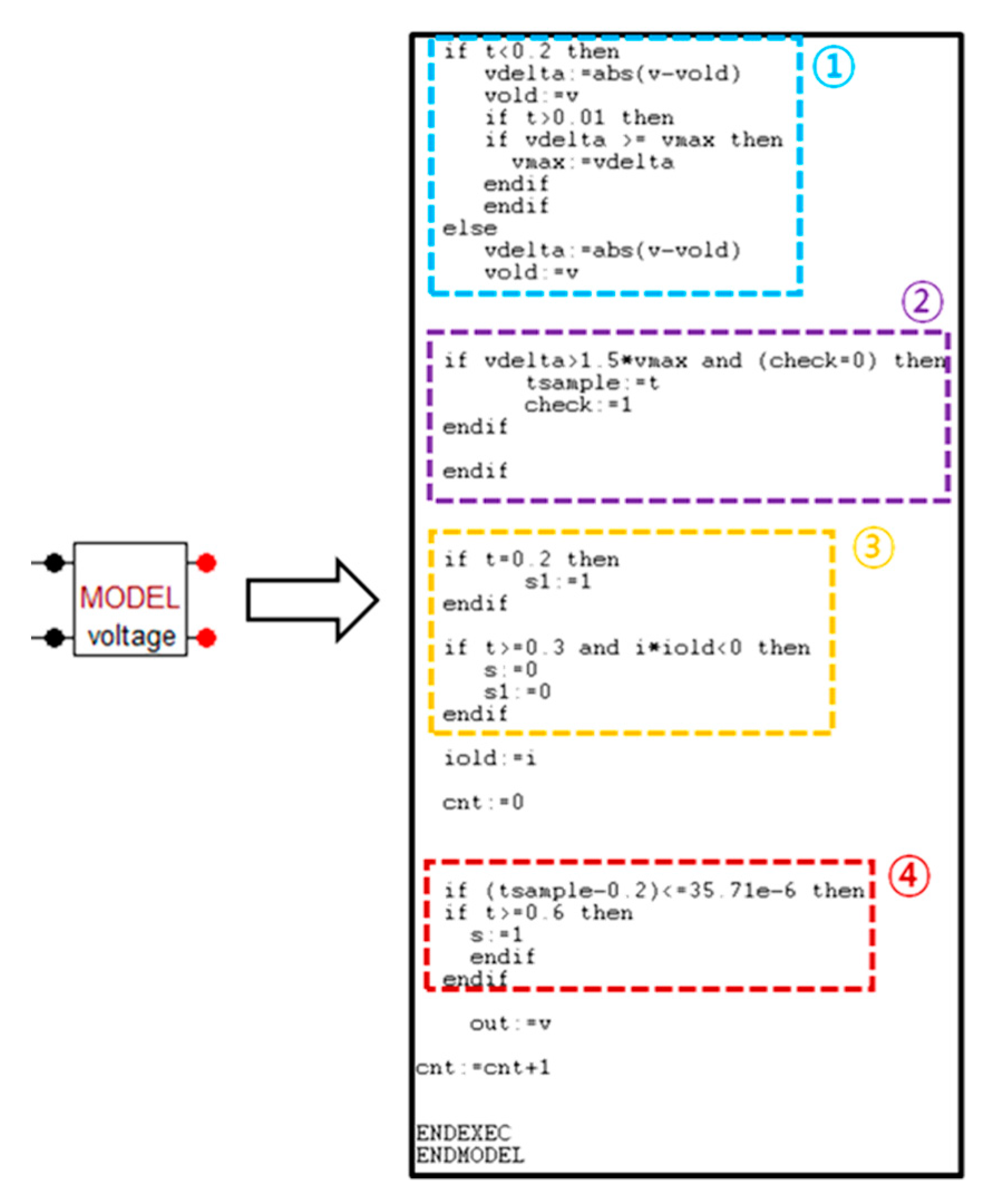
References
- Korea Electric Power Research Institute. A Study on the Optimization of Reclosing Scheme on Transmission and Distribution Line; Korea Electric Power Corp.: Daejeon, Korea, 1998. [Google Scholar]
- Cho, G.J.; Park, J.K.; Sohn, S.H.; Chung, S.J.; Gwon, G.H.; Oh, Y.S.; Kim, C.H. Development of a Leader-End Reclosing Algorithm Considering Turbine-Generator Shaft Torque. Energies 2017, 10, 622. [Google Scholar]
- Seo, H.C. New Adaptive Reclosing Technique in Unbalanced Distribution System. Energies 2017, 10, 1004. [Google Scholar] [CrossRef]
- Granizo Arrabé, R.; Platero Gaona, C.A.; Álvarez Gómez, F.; Rebollo López, E. Novel Auto-Reclosing Blocking Method for Combined Overhead-Cable Lines in Power Networks. Energies 2016, 9, 964. [Google Scholar] [CrossRef]
- IEEE Guide for Automatic Reclosing of Circuit Breakers for AC Distribution and Transmission Lines; IEEE Standard C37.104-2012; IEEE: New York, NY, USA, 2012.
- EPRI. EPRI Underground Transmission Systems Reference Book; The Green Book: Palo Alto, CA, USA, 2012; pp. 2–20, 2–21, 16–22, 16–23. [Google Scholar]
- Louredo, N.H.G.R.; Filho, E.K.; Lopes, J.C.R.; Vale, P.A.M. Overhead to Underground Transmission Line Coupling-Technical Recommendations to Brazilian Utilities; CIGRE B1-107; CIGRE: Paris, France, 2012. [Google Scholar]
- The Protective Relay Subcommittee. Considerations for Transmission Reclosing Practices in the MRO Area; Midwest Reliability Organization: Roseville, MN, USA, 2009. [Google Scholar]
- Jung, C.K.; Park, H.S.; Kang, J.W.; Wang, X.; Kim, Y.K.; Lee, J.B. Development of Fault Location Algorithm and Its Verification Experiments for HVDC Submarine Cables. J. Electr. Eng. Technol. 2012, 7, 859–868. [Google Scholar] [CrossRef]
- Gilany, M.; Din, E.S.T.E.; Aziz, M.M.A.; Ibrahim, D.K. An accurate scheme for fault location in combined overhead line with underground power cable. In Proceedings of the IEEE Power Engineering Society General Meeting, San Francisco, CA, USA, 12–16 June 2005. [Google Scholar]
- Spoor, D.; Zhu, J.G. Improved single-ended traveling-wave fault-location algorithm based on experience with conventional substation transducers. IEEE Trans. Power Deliv. 2006, 21, 1714–1720. [Google Scholar] [CrossRef]
- CIGRE WG B1.19. General Guidelines for the Integration of a New Underground Cable System in the Network; CIGRE: Paris, France, 2004. [Google Scholar]
- Thomas, D.W.P.; Christopoulos, C.; Carvalho, R.J.O.; Pereira, E.T. Single and double ended travelling-wave fault location on a MV system. In Proceedings of the Eighth IEE International Conference on Developments in Power System Protection, Amsterdam, The Netherlands, 5–8 April 2004. [Google Scholar]
- Bains, T.P.S.; Sidhu, T.S.; Xu, Z.H.; Voloh, I.; Zadeh, M.R.D. Impedance-based fault location algorithm for ground faults in series-capacitor-compensated transmission lines. IEEE Trans. Power Deliv. 2018, 33, 189–199. [Google Scholar] [CrossRef]
- Ji, L.; Tao, X.; Fu, Y.; Fu, Y.; Mi, Y.; Li, Z. A New Single Ended Fault Location Method for Transmission Line Based on Positive Sequence Superimposed Network During Auto-Reclosing. IEEE Trans. Power Deliv. 2019, 34, 1019–1029. [Google Scholar] [CrossRef]
- Salim, R.H.; Resener, M.; Filomena, A.D.; Oliveira, K.R.C.; Bretas, A.S. Extended Fault-Location Formulation for Power Distribution Systems. IEEE Trans. Power Deliv. 2009, 24, 508–516. [Google Scholar] [CrossRef]
- Naidu, O.; Pradhan, A.K. A Traveling Wave-Based Fault Location Method Using Unsynchronized Current Measurements. IEEE Trans. Power Deliv. 2019, 34, 505–513. [Google Scholar] [CrossRef]
- Lee, H.; Mousa, A.M. GPS travelling wave fault locator systems: Investigation into the anomalous measurements related to lightning strikes. IEEE Trans. Power Deliv. 1996, 11, 1214–1223. [Google Scholar] [CrossRef]
- Naidu, O.; Yalla, P.; George, N. Auto-reclosing Protection Scheme for Multi-Terminal Mixed Lines Using Synchrophasor Measurements. In Proceedings of the International Conference on Smart Grid Synchronized Measurements and Analytics, College Station, TX, USA, 21–23 May 2019. [Google Scholar]
- Hong, Y.J.; Qingzhang, C.; Dan, W. Traveling wave fault location based on wavelet and improved singular value difference spectrum. In Proceedings of the 2017 International Conference on Circuits, Devices and Systems, Chengdu, China, 5–8 September 2017. [Google Scholar]
- Han, J.; Crossley, P.A. Fault location on a mixed overhead and underground transmission feeder using a multiple-zone quadrilateral impedance relay and a double-ended travelling wave fault locator. In Proceedings of the 12th IET International Conference on Developments in Power System Protection, Copenhagen, Demark, 31 March–3 April 2014. [Google Scholar]
- Lin, S.; He, Z.Y.; Li, X.P.; Qian, Q.Q. Travelling wave time-frequency characteristic-based fault location method for transmission lines. IET Gener. Transm. Distrib. 2012, 6, 764–772. [Google Scholar] [CrossRef]
- Abur, A.; Magnago, F.H. Use of time delays between modal components in wavelet based fault location. Int. J. Electr. Power Energy Syst. 2000, 22, 397–403. [Google Scholar] [CrossRef]
- Hamidi, R.J.; Livani, H. Traveling-wave-based fault-location algorithm for hybrid multi terminal circuits. IEEE Trans. Power Deliv. 2017, 32, 135–144. [Google Scholar] [CrossRef]
- Lin, X.; Zhao, F.; Wu, G.; Li, Z.; Weng, H. Universal Wavefront Positioning Correction Method on Traveling-Wave-Based Fault-Location Algorithms. IEEE Trans. Power Deliv. 2012, 27, 1601–1610. [Google Scholar] [CrossRef]
- Mardiana, R.; Motairy, H.A.; Su, C.Q. Ground Fault Location on a Transmission Line Using High-Frequency Transient Voltages. IEEE Trans. Power Deliv. 2011, 26, 1298–1299. [Google Scholar] [CrossRef]
- Lopes, F.V.; Dantas, K.M.; Silva, K.M.; Costa, F.B. Accurate two terminal transmission line fault location using traveling waves. IEEE Trans. Power Deliv. 2018, 33, 873–880. [Google Scholar] [CrossRef]
- Lan, H.; Ai, T. Application of EMD on single-pole adaptive reclosure of transmission. Dianli Xitong Baohu yu Kongzhi/Power Syst. Prot. Control 2010, 38, 35–39. [Google Scholar]
- Power System Protection Team. A Study on Establishment of Operating Practices Adequacy for Reclosing Relay in Transmission Line; Korea Power Exchange: Naju, Korea, 2013. [Google Scholar]
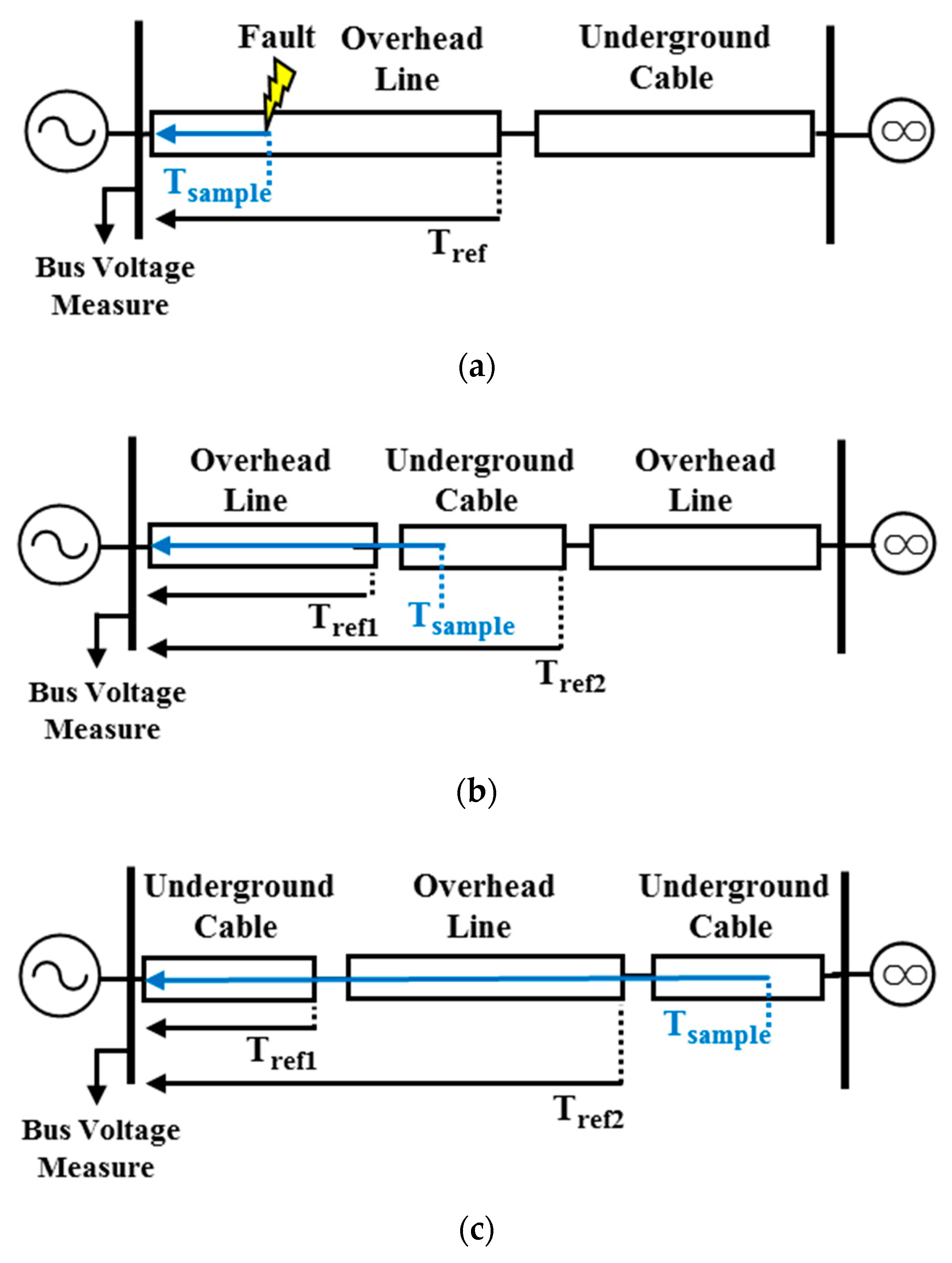
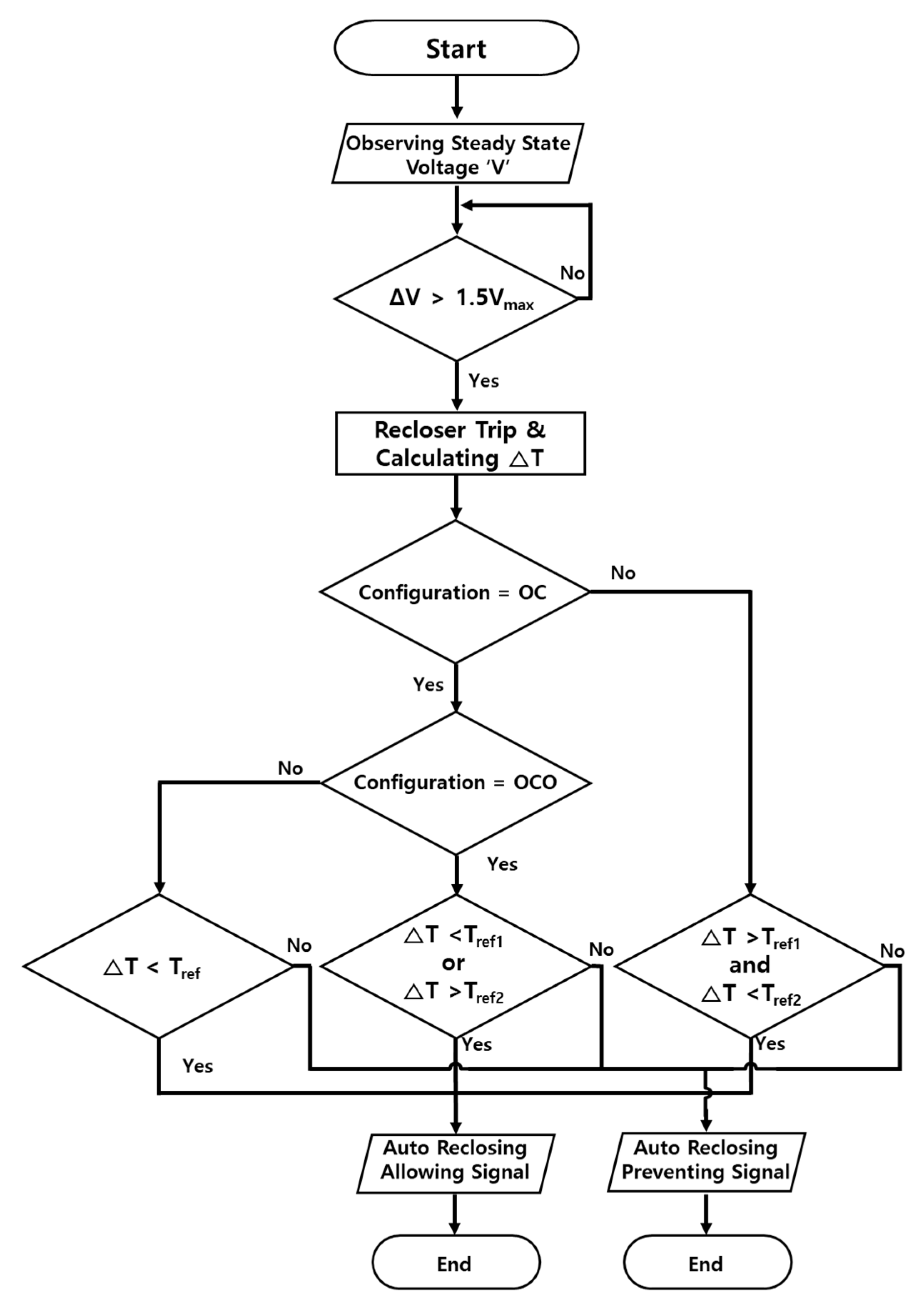
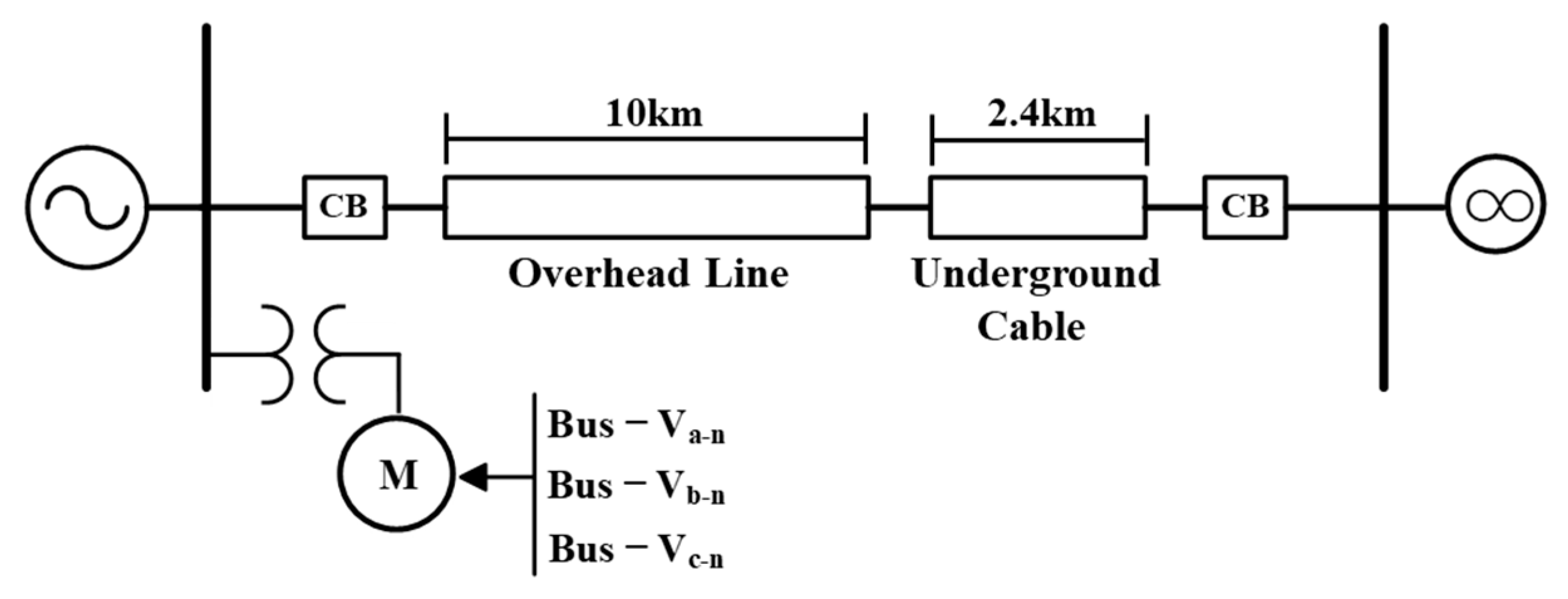
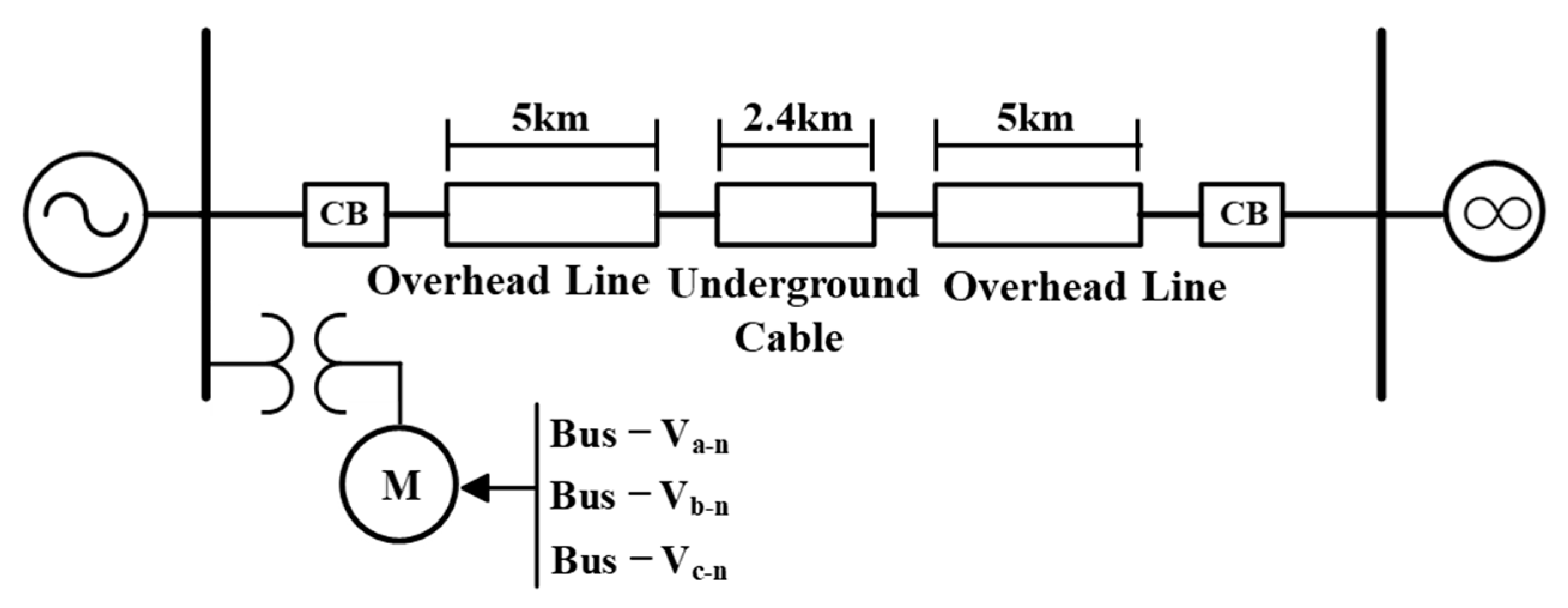
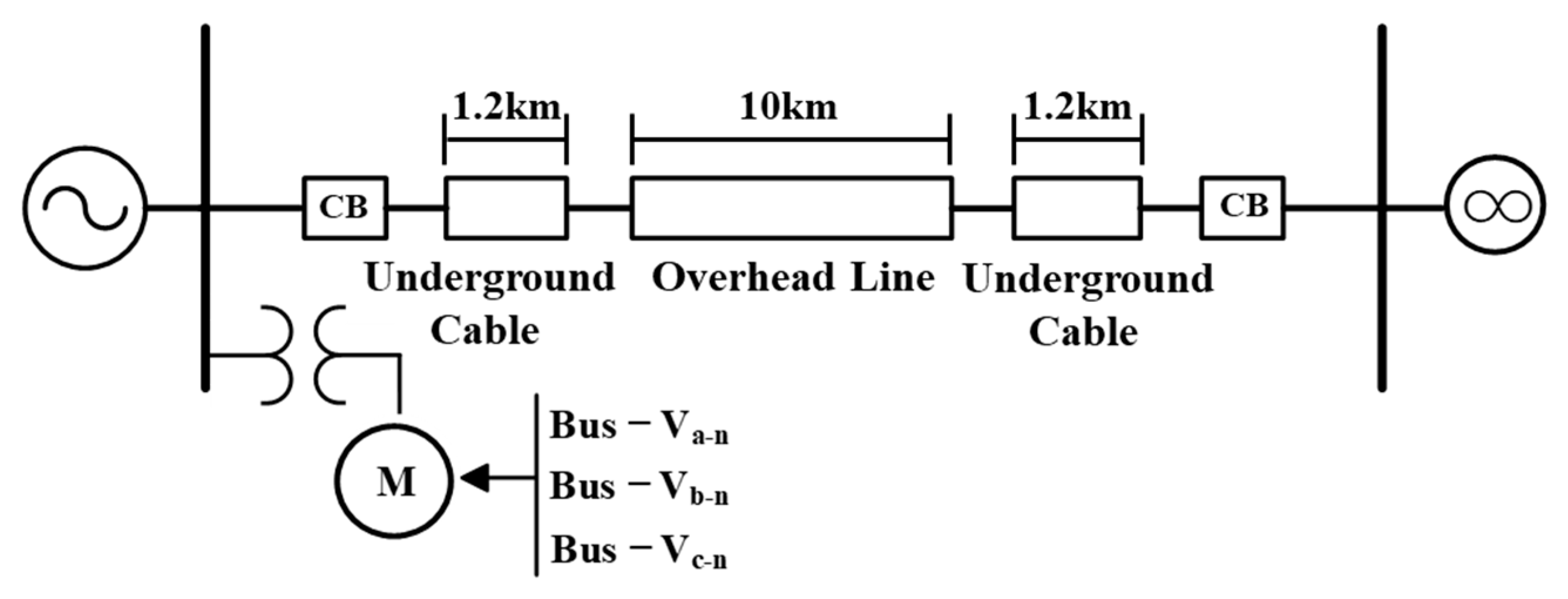
| Nation | Voltage Level | Auto Reclosing Principle |
|---|---|---|
| South Korea | (1) 154 kV | (1-1) Auto reclosing allowed: when portion of underground cable <30% (total system) |
| (1-2) Auto reclosing prohibited: when “OF (Oil-Filled) cable” is used | ||
| (2) 345 kV | (2) Auto reclosing prohibited: when underground cable section exists | |
| Brazil | 138 kV, 230 kV | Among the total ‘12′ mixed system, |
| (1) Auto reclosing allowed: ‘9′ systems | ||
| (2) Auto reclosing allowed only for overhead line fault: ‘2′ systems | ||
| (3) Auto reclosing prohibited: ‘1′ system | ||
| Japan | (1) <154 kV | (1) Auto reclosing allowed: when following conditions are met |
| -Short circuit current < 1000 A, Fault clearing time <1 s, | ||
| -Fire prevention measure is applied to exposed part of cable and adjacent cable, | ||
| -Length of underground cable < 1 km, Length of underground cable <1/3 of overhead line length, | ||
| -Fault will not affect the other cable | ||
| (2) >154 kV | (2-1) Auto reclosing allowed: when following conditions are met | |
| -Length of underground cable <1 km, Length of underground cable <1/3 of overhead line length, | ||
| -Fault will not affect the other cable | ||
| (2-2) Auto reclosing prohibited: when underground cable fault occurs | ||
| Canada | (1) 60~345 kV | (1) Auto reclosing allowed: only for overhead line fault or according to portion of overhead line |
| (2) >500 kV | (2) Auto reclosing prohibited | |
| Sweden | 132 kV | (1) Auto reclosing allowed: when overhead line section is enough long or only for overhead line fault |
| (2) Auto reclosing prohibited: when overhead line section is short |
| Fault Type | Sampling Frequency | Total line Length |
|---|---|---|
| (1) Single line to ground fault (2) 3-phase fault | 30.72 kHz (512 samples/cycle) | (1) Overhead line: 10 km (2) Underground cable: 2.4 km |
| Configuration (OL + UC) | Configuration (OL + UC + OL) | Configuration (UC + OL + UC) |
|---|---|---|
| (1) Tref: 35.71 μs | (1) Tref1: 17.9 μs (2) Tref2: 32.19 μs | (1) Tref1: 7.1 μs (2) Tref2: 42.81 μs |
| Obtained △T and Result of Comparison with Tref | ||||
|---|---|---|---|---|
| Fault Position | △T (μs) | Recloser Operation Signal | ||
| Single Line to Ground Fault | 3-Phase Fault | |||
| Overhead line | 2 km | 7.2002 | 7.2002 | Auto Reclosing Allowed (△T< Tref) |
| 4 km | 14.2932 | 14.2932 | ||
| 6 km | 21.4010 | 21.4010 | ||
| 8 km | 28.5983 | 28.5983 | ||
| 10 km | 35.7062 | 35.7062 | ||
| Underground cable | 10.4 km | 37.8966 | 37.8966 | Auto Reclosing Prevented (△T > Tref) |
| 10.8 km | 40.2063 | 40.2063 | ||
| 11.2 km | 42.6054 | 42.5011 | ||
| 11.6 km | 44.9002 | 44.7959 | ||
| 12 km | 47.2993 | 47.195 | ||
| Obtained △T and Result of Comparison with Tref | ||||
|---|---|---|---|---|
| Fault Position | △T (μs) | Recloser Operation Signal | ||
| Single Line to Ground Fault | 3-Phase Fault | |||
| Overhead line | 1 km | 3.5942 | 3.5942 | Auto Reclosing Allowed (△T < Tref1) |
| 3 km | 10.7020 | 10.7020 | ||
| 5 km | 17.8993 | 17.8993 | ||
| Underground cable | 5.4 km | 20.1046 | 20.1046 | Auto Reclosing Prevented (Tref1 < △T and △T < Tref2) |
| 5.8 km | 22.3994 | 22.3994 | ||
| 6.2 km | 24.7985 | 24.6942 | ||
| 6.6 km | 27.0933 | 27.0039 | ||
| 7 km | 29.4030 | 29.4030 | ||
| 7.4 km | 31.6978 | 31.6978 | ||
| Overhead line | 7.9 km | 33.6051 | 33.5008 | Auto Reclosing Allowed (Tref2 < △T) |
| 9.4 km | 38.8950 | 38.8950 | ||
| 10.9 km | 44.3041 | 44.1998 | ||
| 12.4 km | 49.5940 | 49.5940 | ||
| Obtained △T and Result of Comparison with Tref | ||||
|---|---|---|---|---|
| Fault Position | △T (μs) | Recloser Operation Signal | ||
| Single Line to Ground Fault | 3-Phase Fault | |||
| Underground cable | 0.4 km | 2.4021 | 2.4021 | Auto Reclosing Prevented (△T < Tref1) |
| 0.8 km | 4.6968 | 4.6968 | ||
| 1.2 km | 7.0065 | 7.0065 | ||
| Overhead line | 1.7 km | 8.7053 | 8.7053 | Auto Reclosing Allowed (Tref1 < △T and △T < Tref2) |
| 3.2 km | 14.0995 | 14.0995 | ||
| 4.7 km | 19.4043 | 19.4043 | ||
| 6.2 km | 24.7985 | 24.7985 | ||
| 7.7 km | 30.1033 | 30.1033 | ||
| 9.2 km | 35.4975 | 35.4975 | ||
| 10.7 km | 40.8024 | 40.8024 | ||
| 11.2 km | 42.6054 | 42.6054 | ||
| Underground cable | 11.6 km | 45.0045 | 44.9002 | Auto Reclosing Prevented (Tref2 < △T) |
| 12 km | 47.2993 | 47.1950 | ||
| 12.4 km | 49.6984 | 49.5940 | ||
| Settings for Reference Values in OF Cable System | |||
|---|---|---|---|
| Cable Type | Configuration (OL + UC) | Configuration (OL + UC + OL) | Configuration (UC + OL + UC) |
| XLPE cable | (1) Tref: 35.71 μs | (1) Tref1: 17.9 μs (2) Tref2: 32.19 μs | (1) Tref1: 7.1 μs (2) Tref2: 42.81 μs |
| OF cable | (1) Tref: 35.71 μs | (1) Tref1: 17.9 μs (2) Tref2: 36.03 μs | (1) Tref1: 9.06 μs (2) Tref2: 44.77 μs |
| Configuration (OL + UC) | |||
|---|---|---|---|
| Fault Position | △T (μs) | Recloser Operation Signal | |
| Overhead line | 2 km | 7.2002 | Auto Reclosing Allowed (△T < Tref) |
| 4 km | 14.2932 | ||
| 6 km | 21.4010 | ||
| 8 km | 28.5983 | ||
| 10 km | 35.7062 | ||
| Underground cable | 10.4 km | 38.4927 | Auto Reclosing Prevented (Tref < △T) |
| 10.8 km | 41.3984 | ||
| 11.2 km | 44.3041 | ||
| 11.6 km | 47.2993 | ||
| 12 km | 50.205 | ||
| Configuration (OL + UC + OL) | |||
|---|---|---|---|
| Fault Position | △T (μs) | Recloser Operation Signal | |
| Overhead line | 1 km | 3.5942 | Auto Reclosing Allowed (△T < Tref1) |
| 3 km | 10.7020 | ||
| 5 km | 17.8993 | ||
| Underground cable | 5.4 km | 20.7007 | Auto Reclosing Prevented (Tref1 < △T < Tref2) |
| 5.8 km | 23.6064 | ||
| 6.2 km | 26.4972 | ||
| 6.6 km | 29.403 | ||
| 7 km | 32.3981 | ||
| 7.4 km | 35.3038 | ||
| Overhead line | 7.9 km | 37.1963 | Auto Reclosing Allowed (Tref2 < △T) |
| 9.4 km | 42.5011 | ||
| 10.9 km | 47.8953 | ||
| 12.4 km | 53.2001 | ||
| Configuration (UC + OL + UC) | |||
|---|---|---|---|
| Fault Position | △T (μs) | Recloser Operation Signal | |
| Underground cable | 0.4 km | 2.9981 | Auto Reclosing Prevented (△T< Tref1) |
| 0.8 km | 5.9638 | ||
| 1.2 km | 8.7947 | ||
| Overhead line | 1.7 km | 10.5977 | Auto Reclosing Allowed (Tref1 < △T < Tref2) |
| 3.2 km | 15.9025 | ||
| 4.7 km | 21.2967 | ||
| 6.2 km | 26.6016 | ||
| 7.7 km | 31.9958 | ||
| 9.2 km | 37.3006 | ||
| 10.7 km | 42.6948 | ||
| 11.2 km | 44.3935 | ||
| Underground cable | 11.6 km | 47.2993 | Auto Reclosing Prevented (Tref2 < △T) |
| 12 km | 50.2944 | ||
| 12.4 km | 53.2001 | ||
© 2020 by the authors. Licensee MDPI, Basel, Switzerland. This article is an open access article distributed under the terms and conditions of the Creative Commons Attribution (CC BY) license (http://creativecommons.org/licenses/by/4.0/).
Share and Cite
Sohn, S.-H.; Cho, G.-J.; Kim, C.-H. A Study on Application of Recloser Operation Algorithm for Mixed Transmission System Based on Travelling Wave Method. Energies 2020, 13, 2610. https://doi.org/10.3390/en13102610
Sohn S-H, Cho G-J, Kim C-H. A Study on Application of Recloser Operation Algorithm for Mixed Transmission System Based on Travelling Wave Method. Energies. 2020; 13(10):2610. https://doi.org/10.3390/en13102610
Chicago/Turabian StyleSohn, Seung-Hyun, Gyu-Jung Cho, and Chul-Hwan Kim. 2020. "A Study on Application of Recloser Operation Algorithm for Mixed Transmission System Based on Travelling Wave Method" Energies 13, no. 10: 2610. https://doi.org/10.3390/en13102610
APA StyleSohn, S.-H., Cho, G.-J., & Kim, C.-H. (2020). A Study on Application of Recloser Operation Algorithm for Mixed Transmission System Based on Travelling Wave Method. Energies, 13(10), 2610. https://doi.org/10.3390/en13102610






